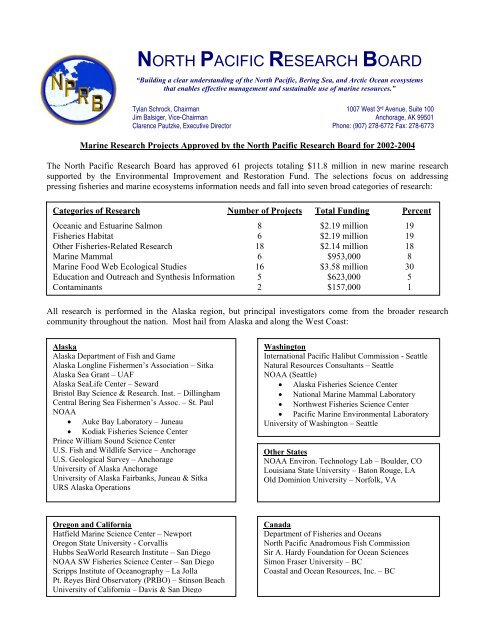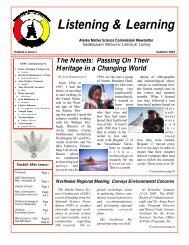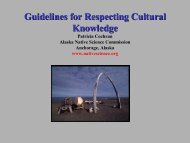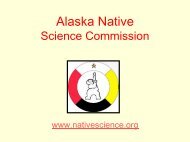61 Approved Marine Rearch Projects for Years 2002 - 2004
61 Approved Marine Rearch Projects for Years 2002 - 2004
61 Approved Marine Rearch Projects for Years 2002 - 2004
- No tags were found...
You also want an ePaper? Increase the reach of your titles
YUMPU automatically turns print PDFs into web optimized ePapers that Google loves.
NORTH PACIFIC RESEARCH BOARD“Building a clear understanding of the North Pacific, Bering Sea, and Arctic Ocean ecosystemsthat enables effective management and sustainable use of marine resources.”Tylan Schrock, ChairmanJim Balsiger, Vice-ChairmanClarence Pautzke, Executive Director1007 West 3 rd Avenue, Suite 100Anchorage, AK 99501Phone: (907) 278-6772 Fax: 278-6773<strong>Marine</strong> Research <strong>Projects</strong> <strong>Approved</strong> by the North Pacific Research Board <strong>for</strong> <strong>2002</strong>-<strong>2004</strong>The North Pacific Research Board has approved <strong>61</strong> projects totaling $11.8 million in new marine researchsupported by the Environmental Improvement and Restoration Fund. The selections focus on addressingpressing fisheries and marine ecosystems in<strong>for</strong>mation needs and fall into seven broad categories of research:Categories of Research Number of <strong>Projects</strong> Total Funding PercentOceanic and Estuarine Salmon 8 $2.19 million 19Fisheries Habitat 6 $2.19 million 19Other Fisheries-Related Research 18 $2.14 million 18<strong>Marine</strong> Mammal 6 $953,000 8<strong>Marine</strong> Food Web Ecological Studies 16 $3.58 million 30Education and Outreach and Synthesis In<strong>for</strong>mation 5 $623,000 5Contaminants 2 $157,000 1All research is per<strong>for</strong>med in the Alaska region, but principal investigators come from the broader researchcommunity throughout the nation. Most hail from Alaska and along the West Coast:AlaskaAlaska Department of Fish and GameAlaska Longline Fishermen’s Association – SitkaAlaska Sea Grant – UAFAlaska SeaLife Center – SewardBristol Bay Science & Research. Inst. – DillinghamCentral Bering Sea Fishermen’s Assoc. – St. PaulNOAA• Auke Bay Laboratory – Juneau• Kodiak Fisheries Science CenterPrince William Sound Science CenterU.S. Fish and Wildlife Service – AnchorageU.S. Geological Survey – AnchorageUniversity of Alaska AnchorageUniversity of Alaska Fairbanks, Juneau & SitkaURS Alaska OperationsWashingtonInternational Pacific Halibut Commission - SeattleNatural Resources Consultants – SeattleNOAA (Seattle)• Alaska Fisheries Science Center• National <strong>Marine</strong> Mammal Laboratory• Northwest Fisheries Science Center• Pacific <strong>Marine</strong> Environmental LaboratoryUniversity of Washington – SeattleOther StatesNOAA Environ. Technology Lab – Boulder, COLouisiana State University – Baton Rouge, LAOld Dominion University – Norfolk, VAOregon and Cali<strong>for</strong>niaHatfield <strong>Marine</strong> Science Center – NewportOregon State University - CorvallisHubbs SeaWorld Research Institute – San DiegoNOAA SW Fisheries Science Center – San DiegoScripps Institute of Oceanography – La JollaPt. Reyes Bird Observatory (PRBO) – Stinson BeachUniversity of Cali<strong>for</strong>nia – Davis & San DiegoCanadaDepartment of Fisheries and OceansNorth Pacific Anadromous Fish CommissionSir A. Hardy Foundation <strong>for</strong> Ocean SciencesSimon Fraser University – BCCoastal and Ocean Resources, Inc. – BC
North Pacific Research Board: <strong>Projects</strong> 1-302928211482516 <strong>61</strong>117 73 53018420271012 1519212623 229 13 24
North Pacific Research Board: <strong>Projects</strong> 31-<strong>61</strong>5835335546573445 5153 39- 4136 323848 5047<strong>61</strong>31374952 5654 605942- 44
Oceanic and Estuarine Salmon Research: $2.19 million1. NPAFC salmon tagging and genetics in the Bering Sea ($190,800)(R0204)North Pacific Anadromous Fish Commission. Salmon tagging and genetics research to understand thedistribution patterns, habitat utilization, and movements of Bering Sea salmon stocks through an at-sea taggingprogram of immature and maturing fish.2. Open ocean salmon stock structure and dynamics in the Bering Sea ($500,000)(R0303)North Pacific Anadromous Fish Commission. Will provide better understanding of salmon community structureand improve ability to predict effects of short- and long-term climate change on ocean production of regionalsalmon stocks. International in scope, involving US, Canada, Russia and Japan. Includes genetic stockidentification and early marine survival of chum, chinook, and sockeye salmon. Continuation of R0204.3. Early marine ecology of juvenile chums in Kuskokwim Bay ($624,025)(R0327)University of Alaska Fairbanks and USGS. Goal is to assess effects of physical and biological environmentalfactors on feeding, condition, and growth of juvenile chum salmon using a bioenergetically-based food webmodel coupled with directed sampling <strong>for</strong> diet composition, growth, size structure, and energy content.4. Evaluation of alternative reasons <strong>for</strong> collapse of Kvichak sockeye runs ($192,850)(R0321)Bristol Bay Science and Research Institute will host series of annual technical workshops to describe changes inenumeration programs <strong>for</strong> Kvichak sockeye over the past 30 years to determine whether the recent collapse wasrelated to freshwater or marine factors. Will conduct comparative analysis of dynamics and age structure ofseveral Bristol Bay sockeye salmon populations.5. Run-timing analysis <strong>for</strong> Bristol Bay sockeye ($24,930)(R0317)Natural Resources Consultants, Seattle. Update and publish migration timing model that quantifies effects ofoceanographic conditions and biological variables on Bristol Bay salmon migration timing and provide <strong>for</strong>ecastof Bristol Bay and Kvichak River sockeye migration timing in 2003.6. Genetic stock identification of Western Alaska sockeye salmon ($216,515)(R0205)NOAA Auke Bay Lab and Alaska Department of Fish and Game. Use of gene markers to track migration andrelative survival of populations of sockeye salmon juveniles exiting Bristol Bay and the eastern Bering Sea.7. Sockeye and coho juvenile survival in estuarine waters of the Copper River Delta ($400,000)(R0310)Prince William Sound Science Center. Couples intensive field surveys and otolith studies to quantify ages ofoutmigration and estuarine residence time <strong>for</strong> coho and sockeye within the Copper River Delta. Will providein<strong>for</strong>mation on survival rates in estuarine areas which are seldom studied.(Note: Project numbers in parentheses may be used to learn more about each project at www.nprb.org under “Research.”)2
8. Statewide data warehouse of salmon size, age and growth records ($43,066)(R0311)Alaska Department of Fish and Game. Will start process <strong>for</strong> establishing an electronic data warehouseenvironment through which historical salmon sampling and scale pattern data <strong>for</strong> salmon size, age and growthrecords can be maintained and updated annually from collections throughout the state.Fisheries Habitat Research: $2.19 million9. Mapping deep sea coral distributions in the Aleutians ($1,303,001)(R0304)University of Alaska Fairbanks, NOAA Auke Bay Lab and Alaska Department of Fish and Game. Detailedmapping of coral and sponge habitats in Aleutians and develop statistical model to predict coral and spongedistribution as a function of measurable environmental characteristics. Determine importance to commerciallyvaluable fish and invertebrates and provide in<strong>for</strong>mation to North Pacific Fishery Management Council.10. Evaluation of essential fish habitat <strong>for</strong> juvenile flatfish around Kodiak ($2<strong>61</strong>,102)(R0301)Oregon State University and NOAA Alaska Fisheries Science Center. Integrated research program, combiningsmall-mesh trawl surveys, higher resolution/spatially explicit camera sled surveys, and field experiments toexamine importance of emergent structure in the behavior, ecology and survival of juvenile halibut and northernrock sole near Kodiak Island.11. Pilot nearshore habitat mapping using acoustic and visual techniques ($120,000)(R0201)Coastal and Ocean Resources, Inc. Pilot biophysical mapping project using a combination of acoustic andvisual tools <strong>for</strong> habitat delineation, including both biological and substrate characteristics in Togiak Bay.12. Investigations of a skate nursery ($140,936)(F0415)NOAA Alaska Fisheries Science Center. Will investigate potential skate nursery area in southeastern BeringSea where fishery data suggest an area of heavy use by skates <strong>for</strong> the deposition of egg cases.13. Ecological value of juvenile rockfish habitat ($163,402)(F0416)NOAA Alaska Fisheries Science Center. Will assess the value of habitat in the Aleutian Islands to juvenilerockfish by examining abundance, condition and growth in five study areas using two acoustical techniques tomap habitat.14. Reproductive ecology of Atka mackerel ($200,000)(F0417)NOAA Alaska Fisheries Science Center and University of Alaska Fairbanks. Will locate and characterize Atkamackerel nesting habitat, analyze the spatio-temporal distribution of populations, produce an embryonicdevelopment series, investigate the temporality of spawning, nesting, hatching, and the annual and spatialvariation in reproductive output.(Note: Project numbers in parentheses may be used to learn more about each project at www.nprb.org under “Research.”)3
Other Fisheries-Related Research: $2.14 million15. Application of new sonar technology to reducing salmon bycatch in pollock fisheries ($121,918)(R0202)NOAA Alaska Fisheries Science Center. New sonar developed to study the dynamic behavior of salmon caughtin trawl nets to help in developing effective excluders that may be used to reduce salmon bycatch in the pollockfishery.16. Environmental cues <strong>for</strong> herring spawning ($131,408)(R0208)University of Alaska Fairbanks and Juneau. Will develop predictive models <strong>for</strong> Pacific herring spawning atTogiak <strong>for</strong> use by managers. Will include spatially explicit models to predict interannual variability ofspawning events, particularly timing and location.17. Two species of rougheye rockfish in Northern Gulf of Alaska ($76,776)(R0209)University of Alaska Fairbanks. Microsatellite and DNA analysis of rougheye rockfish sampled in PrinceWilliam Sound, Cook Inlet, and inside waters of Southeast Alaska to learn whether one rockfish type isassociated with nearshore or inside waters.18. Predator-prey relationships <strong>for</strong> groundfish and <strong>for</strong>age fish ($350,000)(R0305)NOAA Alaska Fisheries Science Center. Continue time series of fish food habits data in the North Pacific byfurther collection of groundfish stomach samples during groundfish bottom and midwater trawl surveys.Analyze fish stomachs collected in 2000-<strong>2002</strong> and update Bering Sea multispecies virtual population analysismodel to provide more current advice on implications of fishing strategies on the ecosystem via the EcosystemsChapter in the stock assessment documents <strong>for</strong> the North Pacific Fishery Management Council.19. Causes of bitter crab disease in Tanner crab ($99,805)(R0306)University of Washington, NOAA Alaska Fisheries Science Center, Alaska Department of Fish and Game.Investigate impact of bitter crab syndrome on North Pacific Tanner crab populations, elucidate the life history ofthe parasitic dinoflagellate Hematodinium and determine whether one or more species of parasiticdinoflagellates cause the syndrome.20. Cultivation techniques <strong>for</strong> Blue King Crab larvae ($85,5<strong>61</strong>)(R0316)NOAA Kodiak Fisheries Science Center. Cultivation and settlement of blue king crab larvae and verification ofability to raise them in laboratory and optimum conditions <strong>for</strong> cultivation. Will study settlement behavior andhabitat selection, survival of larval and juvenile stages, and competitive interactions with red king crab.(Note: Project numbers in parentheses may be used to learn more about each project at www.nprb.org under “Research.”)4
21. Sperm whale interactions with longline fisheries off Southeast Alaska ($184,518)(R0309)University of Alaska Southeast Sitka Campus, Alaska Department of Fish and Game, Hubbs-SeaWorld, AlaskaLongline Fishermen’s Association. Collect in<strong>for</strong>mation, working with local fishermen, on the timing ofinteractions seasonally and diurnally, and identify sperm whales occurring on the fishing grounds throughphotographic identification and genetic samples. Will provide in<strong>for</strong>mation to help minimize sperm whaledepredation on longline gear and sablefish. This project is related to F0412)22. Sperm whale and longline fisheries interactions - passive acoustic component ($68,626)(F0412)University of Alaska Southeast Sitka Campus and Scripps Institute of Oceanography. Will attach a set ofautonomic acoustic recorders to anchor lines of a longline deployment, converting the fishing gear into a verticalacoustic array. This project is related to R0309.23. Short-tailed albatross interactions with North Pacific commercial fisheries ($99,321)(R0322)Oregon State University and U.S. Fish and Wildlife Service. Capture up to 15 short-tailed albatrosses and attachsatellite transmitters <strong>for</strong> 4-6 months to learn about migrations and interactions with commercial fisheries.Characterize oceanographic habitats exploited by <strong>for</strong>aging albatrosses and quantify overlap with fisheries areas.24. Assessment of trawl third wires as a threat to seabirds and short-tailed albatrosses ($100,000)(R0323)NOAA Alaska Fisheries Science Center. Identify extent of use of trawler sonar cables (third wires) andinteractions with seabirds. Provide risk profiles to albatrosses and ways to reduce mortalities.25. Studies of fishing communities in Alaska ($45,000)(R0318)EDAW, Inc. Produce a template <strong>for</strong> collection and analysis of community profile in<strong>for</strong>mation <strong>for</strong> fishingcommunities in the North Pacific and use it to construct four key fishing community profiles. In<strong>for</strong>mation willbe used in various socioeconomic analyses required under NEPA and MSA. Joint funding support from NPRBand NPFMC.26. Video monitoring on factory trawlers ($165,000)(R0325)Digital Observer LLC, Kodiak. Will experiment with using video monitoring gear to develop a verifiablemethod of enumerating bycatch aboard factory trawlers. Assess suitability of in<strong>for</strong>mation to supplementonboard fisheries observer data.27. Health of Pacific herring ($68,198)(R0319)University of Cali<strong>for</strong>nia. Study disease in Prince William Sound and Sitka Sound herring and the role ofpigmented macrophage aggregates to determine relative effects of age, season and gender of herring.(Note: Project numbers in parentheses may be used to learn more about each project at www.nprb.org under “Research.”)5
28. Thermal habitat preferences of Pribilof Island halibut ($92,920)(R0314)International Pacific Halibut Commission and Central Bering Sea Fishermen’s Association. Will determinewhether average sea bottom temperature and its temporal variability correlate with catch rates in the halibutfishery of St. Paul Island. Hope to explain what causes movement and distribution patterns of halibut in shallowcoastal waters of Pribilofs and throughout western Alaska.29. Supply and demand model <strong>for</strong> king crab and snow crab ($80,000)(F0423)University of Alaska Fairbanks. An international econometric model will be constructed, estimated andsimulated to target the primary and most important determinants of demand, estimate the relationship betweenNorth America crab landings and the resulting prices and revenues received <strong>for</strong> the crab, and set a foundationand educate fishery managers and industry participants on market factors which affect price.30. Spiny Dogfish off Alaska ($171,000)(F0418)University of Alaska Fairbanks and University of Washington. Will collect in<strong>for</strong>mation on life history, ecology,population dynamics, and fisheries bycatch <strong>for</strong> spiny dogfish in Alaska.31. Modeling multispecies groundfish interactions ($90,000)(F0419)NOAA Alaska Fisheries Science Center. Work will focus on the update and further development of theMultispecies Statistical Model. This approach will make available the tools used in single-species stockassessment in a multispecies context, providing probabilistic statements on the future state of somecommercially important components of the ecosystem.32. Young of the year Pacific ocean perch genetics ($105,000)(F0420)University of Alaska Fairbanks. Will compare the genetic compositions of previously collected young of theyear Pacific ocean perch with adult geographic population genetic structure.<strong>Marine</strong> Mammal Research: $953,00033. Ecology of ice seals in the Bering-Chukchi Seas ($150,000)(R0312)Alaska Department of Fish and Game. Will develop monitoring program of population status of ringed,bearded, spotted, and ribbon seals in conjunction with annual subsistence seal harvest.34. Feeding ecology and distribution of harbor seals in Prince William Sound ($172,886)(R0313)Alaska Department of Fish and Game and Simon Fraser University (BC). Will examine prey availability andpredation risk to the population dynamics of harbor seals in Prince William Sound. Will also explore howalternative fisheries scenarios might influence <strong>for</strong>aging ecology and demography of seals.(Note: Project numbers in parentheses may be used to learn more about each project at www.nprb.org under “Research.”)6
35. Bering Sea wintering grounds of beluga whales ($1<strong>61</strong>,700)(R0324)NOAA National <strong>Marine</strong> Mammal Laboratory. Will conduct field work in several small bays and inlets onChukotsk Peninsula and attach satellite transmitters to indicate winter movements and diving behavior.Biopsies will be used <strong>for</strong> genetic stock identification and to determine diet and contaminant load. Will identifybeluga stocks that are vulnerable to harvest in Russian as well as U.S. and Canadian waters.36. Bering Sea right whale distribution ($56,117)(R0307)Scripps Institute of Oceanography. Will continue processing acoustic data from SE Bering Sea and combinewith other data to characterize baleen whale abundance, distribution, calling behavior, and habitat preferences.37. Dietary specialization of Bering Sea and Aleutian Islands killer whales ($168,000)(F0411)NOAA National <strong>Marine</strong> Mammal Laboratory and Northwest Fisheries Science Center, and University of AlaskaFairbanks. Will investigate the dietary specialization of killer whales in the BSAI region through the use ofstable isotope and fatty acid analysis.38. Fur seal <strong>for</strong>aging strategies and consequences ($244,000)(F0414)NOAA National <strong>Marine</strong> Mammal Laboratory and University of Alaska Fairbanks. Will compare consequencesof <strong>for</strong>aging in different habitats of the Bering Sea (Pribilofs vs. Bogoslof) in summer versus that of winter<strong>for</strong>aging in the North Pacific.<strong>Marine</strong> Food Web Ecological Studies: $3.58 million39. Monitoring of biophysical moorings in the Bering Sea ($120,690)(R0203)NOAA Pacific <strong>Marine</strong> Environmental Laboratory and Alaska Fisheries Science Center and University of AlaskaFairbanks. This study continues the long-term monitoring of ocean and biological variables at biophysicalmoorings 2 and 4 on the Bering Sea shelf to lay the foundation <strong>for</strong> a knowledgeable <strong>for</strong>ecast of how futurechanges in the climate may impact this ecosystem, its living marine resources and protected marine species.40. Monitoring of biophysical moorings in the Bering Sea ($320,000)(R0315)NOAA Pacific <strong>Marine</strong> Environmental Laboratory and University of Alaska Fairbanks. Will continue two yearsof monitoring of physical and biological environment of the southeastern Bering Sea. This will provideessential in<strong>for</strong>mation during this period of change in the North Pacific and elucidate how the marine ecosystemis changing. This is a continuation of project R0203.41. Monitoring of biophysical moorings in the Bering Sea ($170,204)(F0410)NOAA Pacific <strong>Marine</strong> Environmental Laboratory and Alaska Fisheries Science Center and University of AlaskaFairbanks. Will continue one year of monitoring of physical and biological environment of the southeasterBering Sea. This is a continuation of projects R0203 and R0315.(Note: Project numbers in parentheses may be used to learn more about each project at www.nprb.org under “Research.”)7
42. Plankton surveys across the North Pacific ($180,000)(R0302)Sir Alister Hardy Foundation <strong>for</strong> Ocean Science and DFO-Canada. Will sample plankton using ships ofopportunity crossing the North Pacific and characterize associated environmental conditions. Will enhanceinterpretation of plankton, marine bird and mammal data and improve understanding of marine ecosystem.43. <strong>Marine</strong> bird/mammal observations and continuous plankton recorder program ($60,009)(R0206)Pt. Reyes Bird Observatory Conservation Science. Augment and enhance the existing continuous planktonrecording program on ships of opportunity to conduct observations of marine mammals and seabirds along theCPR survey lines. Related to R0302.44. <strong>Marine</strong> bird/mammal observations and continuous plankton recorder program ($255,690)(F0409)Pt. Reyes Bird Observatory Conservation Science and Duke University <strong>Marine</strong> Laboratory. Will continue twoyears of integrated marine birds, mammals and plankton monitoring program in order to assess yearly variabilityin seabird and marine mammal distributions relative to CPR derived plankton communities, temperature andchlorophyll. Continuation of R0206.45. Detecting change in the Bering Sea ecosystem ($124,084)(R0207)NOAA Pacific <strong>Marine</strong> Environmental Laboratory and Alaska Fisheries Science Center. Develop measures ofecosystem status <strong>for</strong> the Bering Sea based on retrospective data and design a protocol that will test thehypothesis that the effects of environmental change in the Bering Sea often occur from single strong <strong>for</strong>cingevents in the atmosphere and ocean, which lead to an ecosystem reorganization that persists <strong>for</strong> many years.46. Nutritional quality of Alaskan fish <strong>for</strong> predators ($24,782)(R0210)University of Alaska Fairbanks. Funding will support purchase and set-up of equipment to measure the caloricdensity of fish and other prey items to enhance understanding of trophic dynamics and predator-preyrelationships.47. Sinking particles/pelagic food webs in the SE Bering Sea ($21,6<strong>61</strong>)(R0211)University of Alaska Fairbanks. Supports the continued monitoring of zooplankton in the Bering Sea by usingsediment traps on biophysical moorings 2 and 4 on the Bering Sea shelf. Related to R0203.48. Seabird studies on kittiwakes, murres, auklets, and short-tailed albatross ($900,000)(R0320)University of Alaska Fairbanks. Will study feeding ecology of seabirds in southeastern Bering Sea, Pribilofsand Aleutians to determine food availability and stress patterns. Will provide insight on relationships betweenclimate and food web dynamics and a better understanding of how the marine ecosystem may change inresponse to long-term climate changes and global warming.(Note: Project numbers in parentheses may be used to learn more about each project at www.nprb.org under “Research.”)8
49. Forage fish studies near Kodiak ($320,000)(R0308)NOAA Alaska Fisheries Science Center. Will determine relationship of zooplankton prey and <strong>for</strong>age fishes inwestern Gulf of Alaska near Kodiak and how winter conditions influence the prey field and feedingopportunities <strong>for</strong> juvenile Pollock.50. Forage fish assessment to support integrated BSAI ecosystem study ($500,000)(F0401)NOAA Alaska Fisheries Science Center and Environmental Technology Laboratory, University of AlaskaFairbanks, University of Washington, and Louisiana State University. Will assess abundance, distribution, diet,and condition of <strong>for</strong>age fish species and their prey, by assessing abundance, examining food web relationships,testing a potential monitoring program, using underwater acoustics, and airborne visual and remote sensing of anearshore section from Dutch Harbor to Port Moller.51. Ocean circulation models ($75,000)(F0402)University of Alaska Fairbanks and NOAA Pacific <strong>Marine</strong> Environmental Laboratory. Will convene aworkshop on the present state of ocean circulation modeling <strong>for</strong> the Bering Sea and Aleutian Island (BSAI)region of the North Pacific.52. Kelp-grazer interactions ($188,963)(F0407)University of Alaska Fairbanks. Will study kelp-grazer interactions with emphasis on grazing activity,significance of chemical defenses and resource allocation strategies in dominant kelp species in Kachemak Bay.53. Bering Sea variability and coupling ($191,158)(F0408)Old Dominion University Research Foundation (Norfolk, VA). Will utilize co-registered satellite imagery frommultiple sensors to examine temporal and spatial variability of environmental parameters throughout the BeringSea and to evaluate the response of phytoplankton to locally variable <strong>for</strong>cing.54. Tufted Puffins as bioindicators ($131,476)(F0413)University of Alaska Fairbanks. Will utilize quantitative fatty acid signature analysis and stable isotope analysisto estimate the diets of tufted puffins breeding in Chiniak Bay, Kodiak, Alaska.Education and Outreach and Synthesis In<strong>for</strong>mation: $623,00055. Support participation in the Alaska Regional National Ocean Sciences Bowl ($100,000)(R0326)Alaska Sea Grant at University of Alaska Fairbanks. Will provide travel funds <strong>for</strong> participating teams fromAlaska communities off the road system and support regional workshops with interested rural teachers andstudents. Alaska Regional National Ocean Sciences Bowl provides <strong>for</strong> public involvement in marine resourceissues and in capacity building <strong>for</strong> dealing with those issues in rural communities.(Note: Project numbers in parentheses may be used to learn more about each project at www.nprb.org under “Research.”)9









